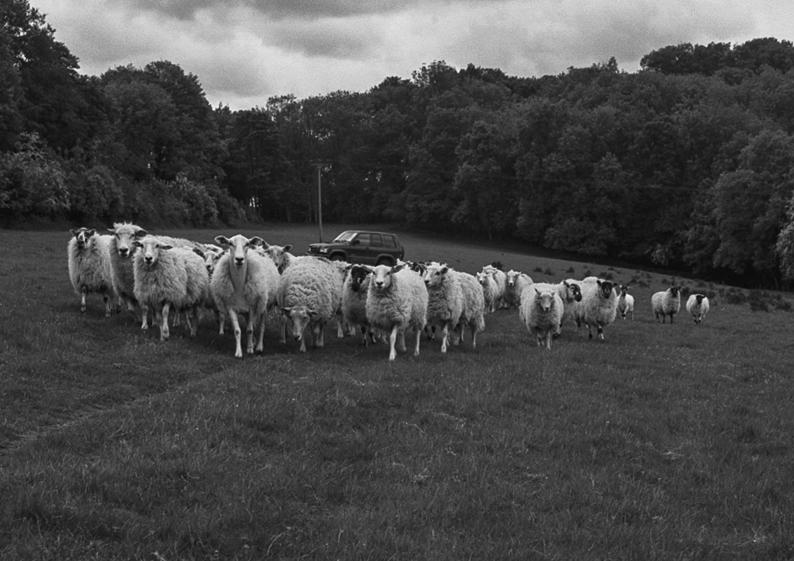


A brief history of sheep shearing by the farmer and writer, Nigel Adams...
It was Jack Conibeer, a wonderful countryman from Devon, who first taught me to shear a sheep using hand clippers. I had learnt to shear with modern electric powered shearing machines many years before in New Zealand so stepping back in time and having the patience to remain bent double for so much longer was a challenge indeed. Jack showed me how to sharpen the hand clippers and the way around the sheep'. He admonished me for making too many clicks with the shears. The sound of the sharp blades hitting each other like a busy hair dressers scissors was not allowed on the shearing shed floors, he explained. You'd be thrown out if you made that racket,' he told me whilst remarking that a good shearer only made one click at the end of each blow' or stripe across the sheep. If you have done it right', he said, your sheep should have a chequerboard pattern all over it and a line running along its spine where the two cutting directions meet. In a competition I like that line even to run up over its tail.'
Another traditional English way of shearing a sheep involved tying its legs together, placing it on a stool and clipping the wool in criss-cross fashion. It was tiring and slow work with no more than 50 sheep clipped per man day. Even so, wool was once the most important export of the British Isles. Kings funded overseas wars through its tax and many small villages and market towns became very wealthy. Villages in rich wool producing areas had churches that were huge in comparison with their population and were known as the Wool Churches.' Travel in the Cotswolds and you will see the tall spires that tell of wealth created by the wool of the Cotswold sheep, the breed that became known as the Cotswold lion'. In the 16th century wool provided for 50% of the total English economy and this important legacy is shown even today in the House of Lords as the Lord Chancellor still sits on the woolsack', a chair stuffed with wool.
We have come a long way from hand clipping and even further from the earliest domesticated sheep whose wool was combed or plucked from the sheep. The earliest mechanical shearing machines were invented in the late 19th century and involved a second person turning a handle which, by direct drive, powered reciprocating blades which were fixed on a hand piece' held by the shearer. At this time Australia and New Zealand were the largest producers of wool and as their industry progressed their shearing process became more and more efficient with large gangs of men shearing huge flocks.
In the 1950's the Bowen brothers of North Island developed a shearing style which eliminated ineffective blows and refined techniques that had been handed down from blade- to machine-shearers. The improved method came to be known as the Bowen style'. Godfrey Bowen was awarded the MBE in 1960 and toured the world teaching his method. During a trip to Russia in 1963 he was even made a Hero of Socialist Labour' by the premier, Nikita Khrushchev.
Until relatively recently wool was an important cash crop for farmers but it has suffered competition from synthetic products and felt the volatility of world commodity prices. Wool prices have struggled for many years even to cover the cost of shearing, but it still has to be carried out for animal welfare reasons. Wool is marketed by the British Wool Board who run 11 grading depot's in the UK. Known as wool staplers, these large warehouses receive every fleece in the country, in total about 30 million kilos (down from a pre- foot and mouth level of 45 million kilos). Amazingly each and every fleece is handled by skilled graders who look closely at the quality of the fleece and are able to place it within one of over 100 grades. First comes the separation into six basic grades, Fine, Medium, Cross bred, Lustre, Hill and Mountain. Then each fleece is judged on the length and strength of its staple (the length of the wool), its colour, the presence of kemp, its condition and so on. Large quantities of one grade are then packed tightly into big bags and it all goes to auction, usually in the sale rooms around Bradford. Buyers can then purchase the grade they need, be it for carpets or your woolly Christmas jumper.
I have never tried coalmining, but I struggle to think of harder work than sheep shearing. It gets in the blood and many shearers find it hard to give up, even though they might wonder why they ever started in the first place! Even old Jack would be impressed by one recent shearing landmark. In July Matt Smith, 32, sheared 731 ewes in nine hours at a farm in Cornwall to beat the previous world record of 721. At one point Matt, originally from New Zealand, was tackling the sheep at a rate of one every 36 seconds. I think I need to practice with my hand blades quite a bit more to beat that!
Words by Nigel Adams. Photos by Jonny Adams.
Nigel Adams is self-employed carrying out a range of countryside management tasks from hedgelaying to the teaching of scything. He has 120 sheep which he grazes on a National Nature Reserve in Oxfordshire.
Sign uphereto be the first to hear about our new collections, events and our latest magazine articles.
Add a comment